Quick Summary:
Frontend scalability is crucial for modern projects. A scalable frontend architecture drives better performance, improves adaptability to changing environments, and ensures a seamless user experience that drives conversation rates. If you have questions like what is frontend scaling or how you scale a frontend application, we have you covered. Here is your ultimate scalable frontend guide in 2024 –
There is a common misconception that the front end of any project is only focused on the visual appeal and elements of the website/app. However, the front end goes beyond aesthetics; it delivers a seamless user experience to the visitors, enhances performance significantly, ensures cross-platform compatibility, and establishes efficient communication between the backend and the users.
Being the bridge between your backend logic and user interaction, it becomes imperative to create scalable frontend structures that can efficiently handle increased user load, allow you to seamlessly integrate new features, keep a check on performance reliability and keep the codebase maintainable. Creating and maintaining a scaling architecture in the front end requires understanding the core components of scalable design and principles of frontend scalability.
But before that, you might wonder: How do I check if my front end is scalable?
We have you covered.
Signs your frontend isn’t scalable – Identifying scalability issues in Frontend
Building scalable frontend architecture is a key enabler of the long-term success of any project. Before understanding how to scale frontend architecture, it is essential to get an assessment of your current frontend project. Here are some common pitfalls that indicate your frontend requires app scaling –
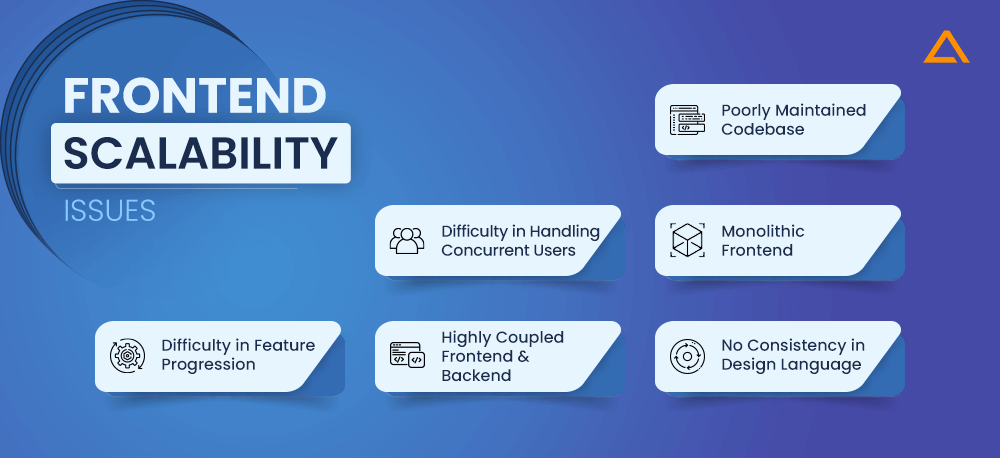
Poorly Maintained Codebase
Review your codebase and see if it is easy to understand, maintain and debug. If you have been having issues with any of those tasks lately, you might face difficulty scaling your front-end project. Lack of proper documentation, not following a standard coding convention, absence of code reusability, and other such factors can result in a poorly maintained codebase.
Difficulty in Handling Concurrent Users
If your frontend architecture struggles to handle multiple users simultaneously, or users complain about unresponsiveness, slower loading time, or unexpected crashes, it indicates frontend scalability inefficiency.
Monolithic Frontend
If you have a monolithic frontend architecture, attaining frontend scalability can be challenging. Monolithic frameworks often have complex frontend architecture, which causes frontend scalability issues.
Difficulty in Feature Progression
If you have experienced performance inconsistencies when adding a new feature or had a difficult time setting a new feature in your frontend without disturbing the entire app’s structure, your frontend needs scalability improvement.
Highly Coupled Frontend and Backend
Tightly coupling the backend and frontend creates complex dependencies where changes in either one would require modifications in the other. This approach kills the scalability. A scalable front end always allows independent development/deployment of backend and frontend components.
No Consistency in Design Language
If your project has had different teams work on the frontend architecture, there might be inconsistencies and fragmentation in the overall design language of the app. When there is no underlying design language that the app’s frontend is based on, it becomes difficult to maintain uniformity, implement changes and maintain a cohesive user experience.
Types of Frontend Scalability
Frontend Scalability isn’t a one-time process you can tweak and finish. It is a set of best practices to follow for scaling the architecture of your front end efficiently. Also, different aspects of frontend scalability need to be considered. Proper knowledge of the types of frontend scalability can help you prioritize your efforts in the direction that’s more important to you. Let’s dive right into the list –
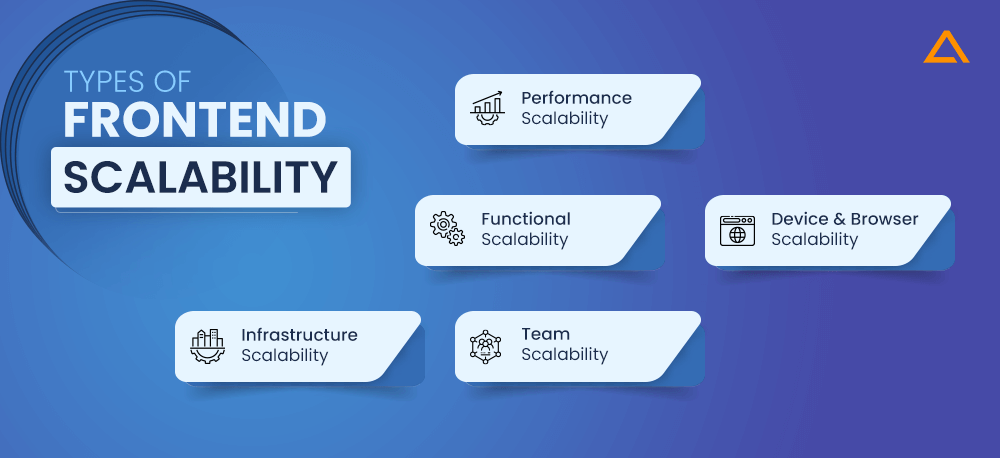
| Type of Frontend Scalability | Description | Ways to Attain Scalability |
| Performance Scalability | Refers to best practices in optimizing frontend application performance for improving load handling capacity, implementing caching, rendering, data fetching strategies, and more. | Implementing lazy loading and code splitting techniques |
| Optimizing image size for faster loading and reduced resource load | ||
| Bundle and compress assets to reduce network requests | ||
| Use caching to store and reuse data | ||
| Functional Scalability | Refers to building modular and extensible frontend using reusable components and clean architecture patterns, which leads to seamless integration of new features without disturbing existing frontend architecture. | Make use of component-based architecture pattern |
| Following SOLID principles to ensure Separation of Concerns and code maintainability | ||
| Implementing well-defined APIs and interactions for independent component interactions | ||
| Device & Browser Scalability | Ensuring the front end performs and behaves consistently across different platforms, browsers, and hardware devices. | Testing and optimizing web apps on popular browsers like Chrome, Firefox, Safari, and others |
| Infrastructure Scalability | Implement horizontal scaling, optimized resource allocation, cloud-based deployment models, and load balancing techniques to ensure your front is scalable for accommodating user base growth. | Implementing horizontal scaling for adding more servers to handle the increased traffic load |
| Make use of load-balancing techniques for distributing user requests across multiple servers. | ||
| Utilizing cloud-based deployment models for auto-scaling and flexible scalability capabilities | ||
| Team Scalability | Refers to a frontend development team’s ability to grow, adapt and collaborate on projects with complex functionalities and architecture. To attain this, the team may require to implement proper structures, guidelines, and best practices and improve overall communication and coordination of the team while increasing the team size too. | Focus on establishing efficient communication channels. |
| Maintain coding standards and utilize version control systems. | ||
| Implement project management practices for promoting collaboration and scalability of the front-end development team. |
Components of Scalable Frontend
Knowing the fundamental building blocks and best practices for scaling frontend architecture is essential. Having a proper understanding of these frontend scalability fundamentals will help you develop future-ready and robust applications and scale/descale your project as per current market conditions so you don’t overspend or underspend on your frontend optimization while ensuring better uptime and seamless user experience. Here are the primary frontend scalability components you should know –
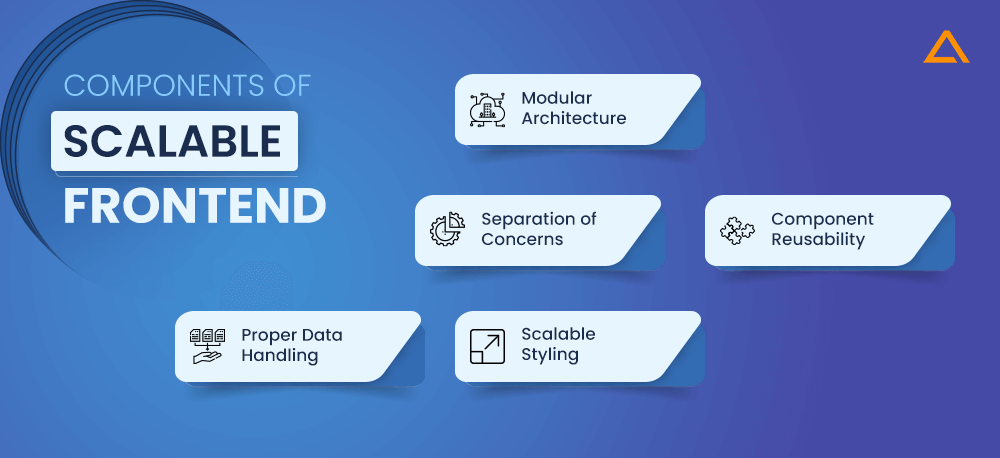
1. Modular Architecture
As we discussed previously, monolithic architecture limits scalability. What’s the alternative, then? Breaking down the giant monolithic frontend to manageable and self-sufficient micro frontends modules. This modular approach promotes scalability best practices like code reusability, easing adding/removing feature processes and reducing dependencies.
Here are the benefits of implementing modular architecture to make your frontend scalable –
- Better Code Organization and Reusability
- Scalable Development & Improved Collaboration
- Better Flexibility & Adaptability
- Scalable Performance with Reliable Load Handling
- Easier Maintaining & Debugging
Also Read: – Micro Frontend Architecture 101 –Best Practices, Benefits, Limitations & Challenges
2. Separation of Concerns
Separation of Concerns is one of the most fundamental concepts that is a core component of scalable frontend architecture. This divides the frontend code into distinct modules or layers based on certain common characteristics like responsibilities. A classic example is separating the business logic layer (JavaScript) from the presentational layer (HTML, CSS), which helps improve code maintainability and clarity. Through the proper separation of concern implementations, frontend developers can debug, test and modify individual frontend components more quickly, making the overall frontend scalable and adaptable.
Here are the benefits of implementing an SoC pattern for making your frontend scalable –
- Improved Collaboration and Teamwork
- Improved Code Maintainability
- Reusability and Extensibility
- Improved Testability
- Reusability and Extensibility
- Maintaining Uniformed Styling
3. Component Reusability
This point can’t be stressed enough; reusable components are the developer’s magic hat to the scalable front end. Designing components that can be used across various parts of your application structure helps streamline the development process, improves code consistency, and avoids code duplication. You can also easily integrate new features and enhance the overall codebase scalability by allowing flexible adaptation to changing requirements of your scaling front.
Here are the several benefits of following code reusability best practices to make your frontend scalable –
- Improved Development Efficiency
- Standardization and Codebase Consistency
- Code Maintainability and Refactoring
- Better Collaboration Opportunities
- Scalability and Room for Adaptability
4. Proper Data Handling
How you handle and present all the data on your front end plays a vital role in developing scalable front-end architecture. By implementing techniques like caching, paging, and lazy loading, you can optimize the load of data retrieval while reducing network requests. Efficient data handling can enable your frontend to handle more concurrent user interactions and larger datasets and optimize responsiveness and performance significantly.
- Improved Performance and Scalable Data Presentation
- Real-Time Updates and Better Interactions
- Data Privacy and Data Security
- Scalable Data Presentation
- Optimized Bandwidth and Resource Utilization
5. Scalable Styling
Scalable Styling is a frontend approach and technique for managing and maintaining styles in your frontend app as it grows in complexity and scale. The purpose is to implement a styling system that can adapt and accommodate your application’s changing requirements without compromising the overall frontend performance and code maintainability. It is often a best practice to follow a centralized styling system that promotes consistency and standardization, modular and reusable styles and enables dynamic and responsive styling.
Here is how implementing scalable styling practices can help make your frontend architecture scalable –
- Brand Consistency and Identity
- Reusability and Efficiency
- Flexibility and Improved Adaptability
- Collaboration and Design Efficiency
- Consistent Updates and Easier Maintainability
Principles of Achieving Scalable Architecture in Frontend Projects
Now let’s discuss the important principles of scalable frontend architecture. These principles are more like a set of front end practices and guidelines that help frontend developers design, develop and deploy frontend projects that can grow or adapt to the changing requirements of the project. By adhering to the principles mentioned here, you can develop a modular, maintainable, and reusable codebase that allows room for collaboration and improves the scalability of your front-end applications. Without any further ado, let’s get right into it –
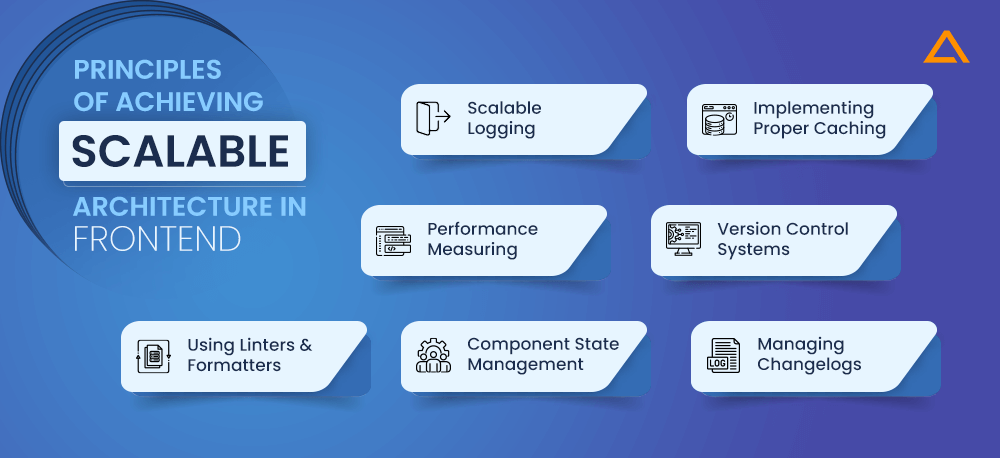
Scalable Logging
Scalable Logging is an essential principle of building scalable frontend applications. You need to develop a robust logging mechanism that can capture and track application events, performance metrics, and errors. Scalable logging allows developers to monitor frontend performance, debug the application and identify possible bottlenecks, and create an informed strategic frontend scalability plan of action.
Scalable Logging Techniques to Implement for Scalable Frontend
| Scalable Frontend Logging Technique | Explanation |
| Error Logging | Capturing errors or exceptions in the front end of your application for tracking and diagnosing the issue in production. |
| Performance Logging | Logging frontend performance metrics like page load times, first content paint, network requests, and more. |
| User Event Logging | Logging user interactions, actions, or events in the front end for understanding user behavior and pattern. |
| Log Severity Levels | Prioritizing log warnings as per severity levels so developers can filter log messages based on their priority. |
| Contextual Logging | Providing contextual information in log messages like the session ID, request parameter, user details, or request parameters for improving troubleshooting and analysis. |
| Log Analysis | Using Log Analysis Tools for identifying and processing log data for deriving meaningful insights and identifying anomalies and trends. |
Implementing Proper Caching
Caching is the bread and butter for maintaining performance and promoting scalability of frontend projects. Frequent caching can reduce the load of repeated server requests, minimize server load and enhance response times. You can implement scalable caching strategies like client-side caching techniques like HTTP caching headers, in-memory caching solutions, or browser caching. Moreover, you can use CDN for caching and distributing static assets globally. By establishing proper caching techniques, you can reduce the load on the server, reduce data transfer and improve the responsiveness and scalability of your frontend application.
Strategic Scalable Caching Techniques for Frontend Scalability
| Scalable Frontend Caching Technique | Explanation |
| Browser Caching | Caching CSS, JavaScript, and images in the user’s browser |
| HTTP Caching | Utilizing HTTP headers like ‘Cache-Control’ and ‘ETag’ for controlling and specifying caching behavior |
| Server-Side Caching | Caching responses on the server side to improve response times |
| CDN Caching | Caching static assets on CDN servers to reduce latency and loading times |
| Database Query Caching | Caching commonly used database queries to avoid redundant database operations |
PLANNING TO HIRE WEB APP DEVELOPMENT COMPANY?
WE OFFER WEB APPLICATION DEVELOPMENT FOR ALL KINDS OF BUSINESSES THAT ARE EASY TO SCALE, HIGH-PERFORMING, INTUITIVE, SECURE, AND BEST-IN-CLASS.
Performance Measuring
Proper performance measuring is crucial for achieving measurable scalability in your front-end application. You should set up mechanisms that can measure the overall performance of your application, like page load times, rendering times, network requests, and other important metrics. Constant performance monitoring through various performance monitoring tools and techniques can help identify performance bottlenecks, optimize critical areas and ensure your frontend’s capabilities of surges and spikes in traffic with efficiency. A reliable source to check your website performance is GTMetrix.
Key Performance Metrics to Measure for Frontend Scalability
| Frontend Scalability Performance Metrics | Explanation | Ideal Standard Range |
| Page Load Time | Time taken for the webpage to fully load in a web browser with all its resources. | Less than 3 seconds |
| First Contentful Paint (FCP) | Time taken for the first element of the webpage to be rendered on the screen | Less than 1 second |
| Time to Interactive | Time taken for the webpage to become fully interactive and responsive to user inputs. | Less than 5 seconds |
| Network Requests | Number of HTTP requests made by frontend for retrieving CSS, Images, or JS files | As less as possible |
| Time to First Byte | Time elapsed between users’ request and the first byte of the received response | Less than 200 ms |
| JavaScript Errors | Number and type of errors encountered when JavaScript code is executed on the client-side | 0 errors |
| Cache Hit Ratio | The percentage ratio of resource requests that are fetched from the cache in place of the server | More than 90% |
| DOM Content Loaded | The time it takes for an HTML document to be fully parsed and the DOM Tree to be entirely constructed. | Less than 1 second |
Version Control Systems
Version Control Systems enable developers to track changes in their codebase, collaborate with other remote frontend developer teams, and easily manage codebase versions. Popular VCS include names like Git, SVN, and others that can help you maintain and manage a clean and structured codebase with the flexibility of rollbacks if and when needed. Version control systems also allow room for scalability by providing methods of managing a growing codebase and handling concurrent workflows.
| Version Control System | Explanation |
| Git | The most popular Distributed VCS generally used for software development. Allows collaboration, branching, and merging of code. Known for its scalability. |
| Subversion (SVN) | Centralized VCS that helps track and manage changes to files and directories. Provides versioned repositories and supports collaboration but maintains centralized architecture. |
| Perforce | Another Centralized VCS generally used at enterprise levels. One of the most robust versioning systems that provide file locking and can be integrated with other tools seamlessly. It is known for scalability, performance, and handling large codebases. |
| Mercurial (Hg) | Similar Distributed VCS similar to Git that offers decentralized version tracking, collaboration, and branching control. It has a simple UI and is meant for smaller projects or teams. |
Using Linters and Formatters
Linters and Formatters are crucial in enhancing frontend scalability since it enforces code consistency, improve code readability, and reduce the chances of common programming errors.
Linters are used for analyzing the codebase for potential bugs, issues, and coding style violations. They help maintain code standards and detect any pattern or anti-pattern that could limit the scalability of your project. Finding and flagging these issues early in the development life cycle reduces the chances of running into performance and scalability bottlenecks by a handsome margin.
Formatters are used for applying formatting rules over the codebase. It helps eliminate avoidable conflict about code style between different teams and ensures that the project follows a uniform coding structure. Since the code is automatically formatted, developers get access to a more readable, understandable, and maintainable codebase.
Popular Linters and Formatters for Frontend Scalability
| Linter/Formatter | Explanation |
| ESLint | Popular JavaScript Linter that analyses code for potential errors, maintains code quality and enforces coding styles. |
| Prettier | Code formatter that enforces consistent code style by automatically formatting code as per a predefined set of rules and regulations. |
| HTMLHint | Designed for HTML that helps identify potential errors, enforces coding standards, and help maintains a clean and maintainable HTML codebase. |
| HTML-CSS-JS Prettify | Code formatter for HTML, CSS, and JS to format and beautify code based on predefined rules |
Component State Management
Component State Management is one of the most important frontend architecture practices for scalability. It is concerned with properly managing the state of components within your application and paying special attention to its handling and scalability.
Components in frontend development have internal states that determine their appearance and behavior. With increasing complexity and size, managing these states becomes complex and difficult. If you don’t pay attention to these states, it can lead to issues like performance bottlenecks, data inconsistency, and problems in code maintenance. To achieve component state management, you need to have a centralized state management solution in place with an immutable state, selective rendering, asynchronous state updates, and proper component composition.
Also Read: – React State vs. Props: Understanding the Difference
Managing Changelogs
Changelogs are the most undermined yet crucial aspect of building a scalable front end. They provide a properly documented history of all changes made throughout the history of the application’s codebase. This record outlines all the development efforts, additions, removals, bug fixes, and project enhancements of different release versions of the front-end application.
Having a proper changelog can help improve communication and project transparency, version tracking and compatibility, bug tracking and issue resolutions, documentation, and historical referencing, and work as a supporting document for client-user communication.
Components of Changelog that you should keep in mind for scalable frontend development
| Changelog Component | Explanation |
| Version Number | Unique identifier number for each release variant of frontend application. |
| Improvements | Description of general improvements regarding your project’s performance, user experience, and functionality. |
| Bug Fixes | Details about bugs or any issues identified in the previous built and fixed in the newer one. |
| Features | List of newly added features or enhancements to the application’s version in a particular version. |
| Deprecations | Alerts about any feature, API, or functionality marked as deprecated could be removed in future versions. |
| Removals | Mentions about any noticeable or important feature being removed in the current version. |
| Documentation | Links and references to new documentation related to front-end applications. |
| Dependencies | Information about any updates to dependencies or libraries that affects frontend architecture and functioning. |
| Contributors | Credits and acknowledgments to teams or individuals who contributed to the frontend development of that specific version |
Scaling Architecture Ranking as Per Type of Frontend Architecture
There are multiple frontend architecture patterns that you can implement for establishing the frontend of your project. Different architectural patterns bring different benefits and functionalities and serve different purposes. However, comparing them from an ease of scalability point of view can be interesting to see which frontend architecture is most scalable. Let’s get started –
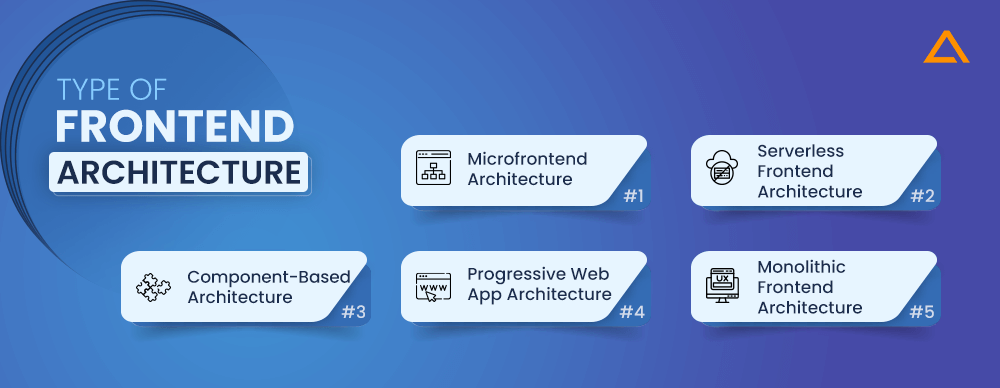
Note: We’ll rank the frontend architecture patterns from the least scalable to the most scalable. However, these rankings are subjective to individual projects and differences of opinion. The orders are just for providing a basic reference point.
| Scalability Ranking of Frontend Architecture | Type of Frontend Architecture | Scalability Features |
| #5 | Monolithic | · Horizontal scaling by deploying multiple instances |
| #4 | PWA | · Cost Efficiency since you pay for actual usage · Offline functionality · Responsive design |
| #3 | Component-Based | · Reusability of components for faster development · Modular development and reduced code duplication |
| #2 | Serverless | · Automatic Scaling on Demand · Dynamic Resource Provisioning and Allocation |
| #1 | Micro frontends | · Independent scaling of components · Distributed and fault isolation |
#5- Monolithic Frontend Architecture
We discussed the monolithic frontend in length earlier and understood its limitations towards frontend scalability. You cannot run individual operations or scale parts of the app at a time; the entire app’s codebase needs to be worked upon together, which could result in a delayed scaling process and possible errors in the other aspects of the application. However, if you follow a monolithic frontend architecture, you could still benefit from horizontal scaling or caching mechanisms.
#4- PWA – Progressive Web App Architecture
PWAs provide much better scalability than monolithic frontend architecture and are an ideal architecture pattern for developers looking to combine the features of mobile and web applications. They are built to be fast and reliable and provide a native-like app experience. By utilizing service workers and caching mechanisms, they manage resource handling efficiently. You can achieve scalability in PWAs by caching static assets, using lady-loading-like techniques, and more.
#3- Component-Based Architecture
Component-Based Architecture improves frontend scalability by leaps and bounds. It focuses on reusing components and independently scaling specific components or groups of components. This modular approach aligns with scalable principles, making the maintenance and coding process easier for developers. It enables automatic scaling on demand.
#2- Serverless Frontend Architecture
Serverless architecture is a practice where frontend applications are run on cloud platforms with abstracted infrastructure. This allows for automatic scaling based on demand, ensuring your app can handle and accommodate the fluctuations in traffic while maintaining reliable uptime. The resources are provided dynamically and when needed, allowing for a more efficient frontend scaling project.
#1- Microfrontend Architecture
As discussed earlier, micro frontends break the traditional monolithic architecture into manageable modules that are self-sufficient and can communicate with each other via APIs. Each module is responsible for a specific feature or functionality which enables teams to work on the modules independently. This offers the highest scalability as individual aspects can be scaled without affecting the other parts of the frontend architecture. It also allows flexibility in technology choices and faster development and deployment cycles.
Wrapping Up
This is your ultimate guide to scale frontend applications and prepare your project for increased traffic, concurrent users, load balancing, adding new features, and other important tasks to ensure your project remains highly performant and secure with changing needs of your clients and business.
have a unique app Idea?
Hire Certified Developers To Build Robust Feature, Rich App And Websites.
Also Check:
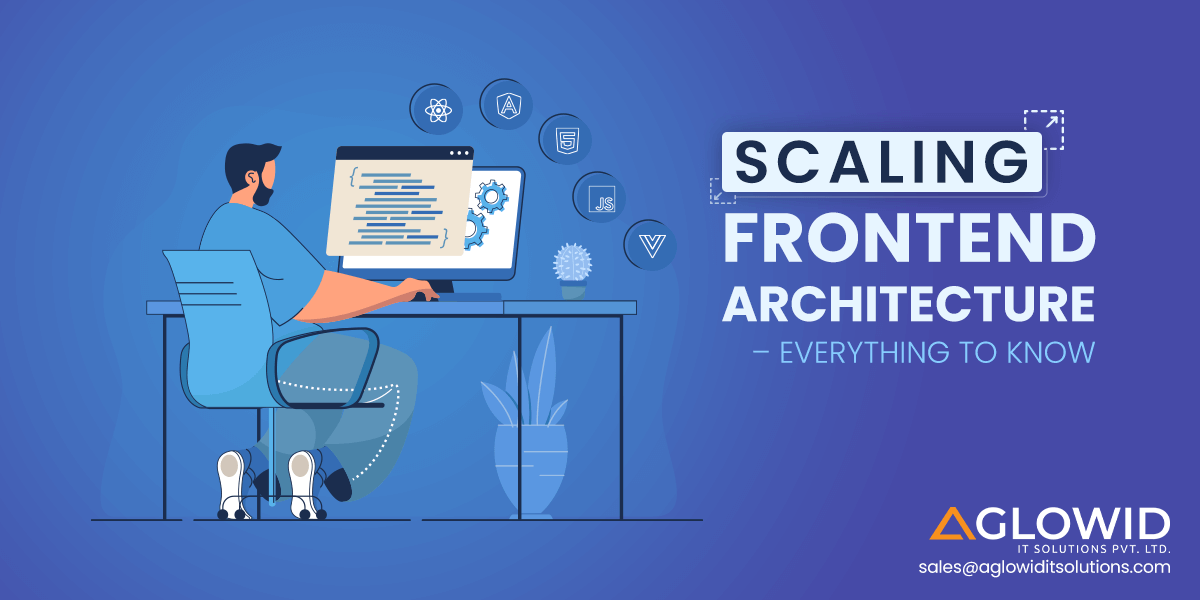
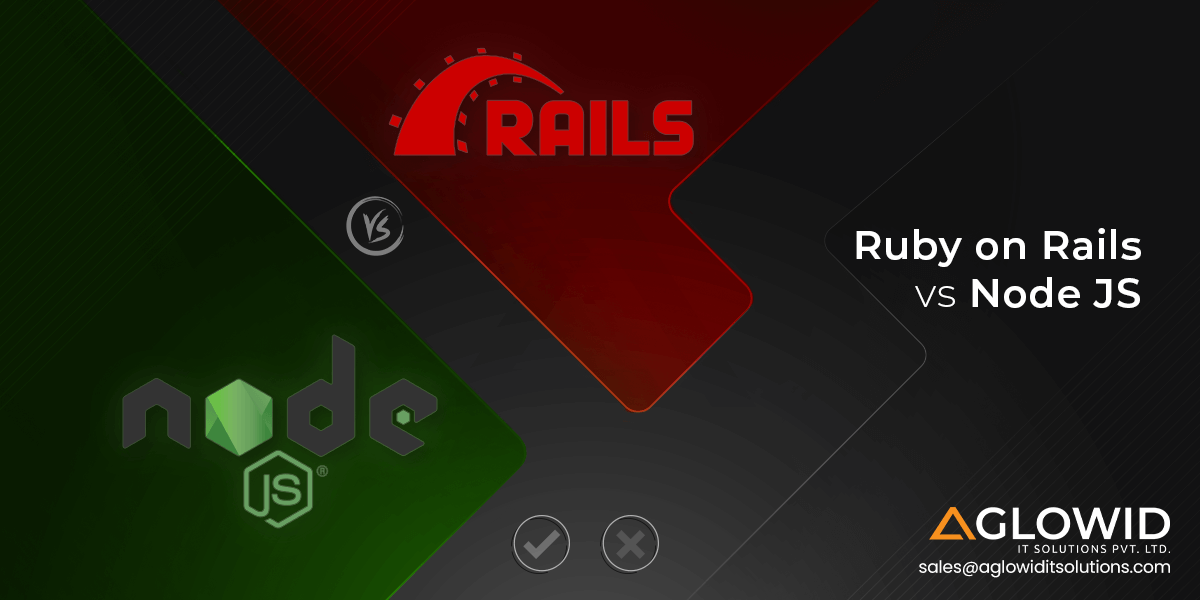



 Say
Say